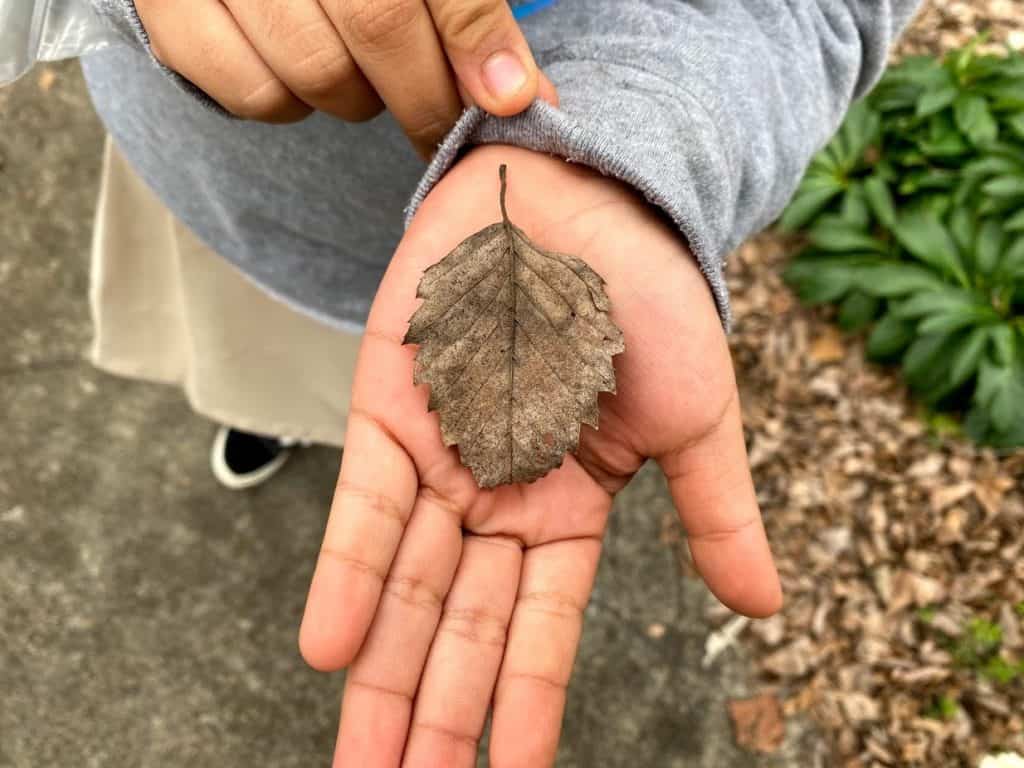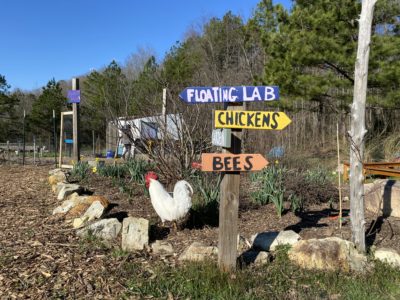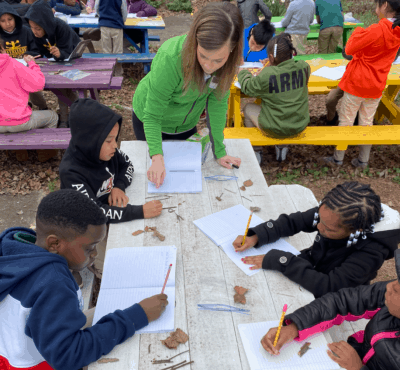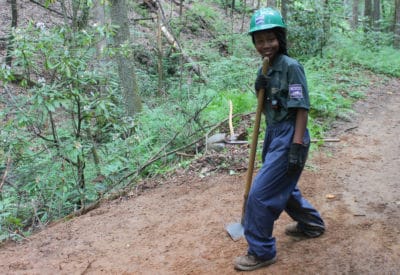Out Teach is a nonprofit that normally provides job-embedded coaching and on-site professional learning to teachers in under-served communities, showing them how to use hands-on outdoor lessons to boost STEM instruction.
To help teachers and parents struggling to navigate new remote learning challenges during the COVID-19 pandemic, the instructional coaches at Out Teach recently switched gears and went into overdrive.

This month, to help teachers balance out worksheets and online programs, the instructional coaches at Out Teach pivoted to create standard-aligned hands-on outdoor activities to get students away from screens for a bit, out of their packets, and deeply engaged in learning on their own.
Two Out Teach instructional coaches, Allie Graybeal of North Carolina and Jarri Goodman of Georgia, took a break from working one-on-one with teachers planning at-home lessons to put their heads together. Below, they share their top five tips for creating student-driven outdoor lessons.
1. Go outdoors for a reason
Lessons are more effective when they’re authentic and meaningful. Think about what an outdoor experience can really add to a lesson. While reading outside can be lovely, to use the space effectively for ELA (English language arts) instruction, perhaps have students go outdoors to make observations about the natural object of their choice, and then write a poem using those observations.
For math, simple counting exercises can be done inside or out, so why not expand on the lesson to explore concepts like weight or volume? Ask questions like: What’s heavier, ten rocks or ten pine cones? What takes up more room and why? Deeper lessons like these let students explore real world examples of complex concepts in action.
Meaningful division and multiplication lessons abound outdoors. Students can divide garden beds for planting or calculate how many seeds one plant can produce. Math and ELA lessons are just the beginning of the possibilities.
Our primary focus is on science, which is a natural fit, since many states’ elementary earth, life, and physical science standards take place outdoors. For example:
- Kindergartners can study basic seasonal changes.
- First graders often learn about plant life cycles.
- Second graders study animal life cycles, including bugs, which can be found in almost any outdoor environment.
- Third through fifth graders study weather.
- Fourth and fifth graders often study land forms.
- And most elementary grades study ecosystems.
In addition to thinking about why a particular lesson can be deepened with outdoor experiential learning, teachers must also think practically. While most students will have access to an outdoor view or a sidewalk, we should not assume that students will have access to spaces such as yards or parks, or tools such as shovels or garden hoses.
Also, since many students will be doing these lessons on their own while home during COVID-19 restrictions, think through what level of parental supervision is truly needed. Perhaps just a quick walk with an older family member outdoors can kick off a lesson, which students can then complete back inside.
2. Keep it simple, but not prescriptive
Despite the current challenges teachers are facing, or in fact, because of them, now is a great time to give students some “stretch” critical thinking tasks. This means designing instructions that are simple enough for students to follow, with goals they can achieve, while leaving enough flexibility to build valuable skills like science engineering practices.
For example: When creating a lesson on comparing and contrasting the form and function of leaves from different plants, a teacher might also instruct students to develop the model with which they share their observations. This way, in addition to learning key facts, students must think critically about the world around them, analyze their data in a robust and meaningful way, and boost their communication skills by thinking about how their readers will understand the model they’ve created. Some students use various graphic organizers to plan and conduct their investigation. These visual tools represent the students’ thinking and their explanation of real-world events.
Having students work from home also gives teachers an opportunity to incorporate more student choice into lessons, which increases motivation and personalization. Giving students the agency to pick the thing they study, such as choosing the seeds they plant, nurtures intrinsic motivation, which in turn curbs behavior and distraction issues.

3. Ask the right BIG questions
Think of this as a standards-aligned Socratic method. Asking students big enough questions not only helps them struggle the right amount, but it encourages students to ask themselves their own big questions, fueling future curiosity.
Aligning these questions with the NRC (National Research Council) Framework also builds recognition of cross-cutting concepts such as patterns, cause and effect, and structure and function. An easy example would be instead of asking students what the weather is, try asking them what it was, what it will be, and why. To find other options of some big questions, click here.
4. Integrate everything
In the outdoors, there is room to integrate almost any subject as well as 21st century skills and social emotional learning (yes, even during social distancing). The outdoors provide unlimited opportunities for exploration. When learning about the real world through real experiences, information isn’t broken up into silos. Teachers can use this built-in integration to fuel learning remotely with rich, complex activities that allow students to build cross-curricular knowledge and skills.
An outdoor science lesson could have students studying informational texts on weather phenomena, and making their own observations at home, then using math to process their data and make weather predictions for their favorite city, or around their favorite outdoor event. Perhaps during school closings, they can confer with family members, or remotely with classmates, on how best to communicate their predictions and then come up with creative ways to report their findings.
5. Think long-term
This too shall pass. This is an incredibly challenging time for everyone, but both students and teachers can use this period to build skills that will last.
Students can use this time to build foundational knowledge that will help them later on. Have third graders who will need to calculate area and perimeters next year? Get them used to that vocabulary now on a walk around the perimeter of a park or by thinking about the size of the area needed for an outdoor activity.
Educators who learn to use experiential outdoor teaching techniques now can use them to even greater effect when the schools’ doors open again. Being able to increase student engagement and the effectiveness of lessons will always be helpful. So, after you finish celebrating your students’ return into your classroom, start taking them outside for experiential lessons that accelerate learning across the board.
Out Teach is posting free outdoor learning activities for students here. For more information and resources from Out Teach instructional coaches, follow us on Twitter at @OutTeachEd.
Please feel free to ask us questions and share your achievements. We’re all in this together.
Recommended reading




